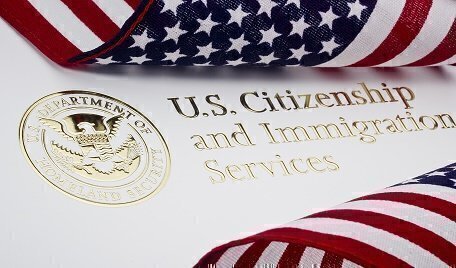Moving with unusual speed, the Supreme Court indicated on Monday that it will take its first look just 11 days from now at the Trump Administration’s new appeal seeking to defend the President’s third immigration order. That will no doubt force an earlier reply by the order’s challengers, and an earlier decision by the Justices on whether to grant full review – which seems all but certain.
 The Justices acted on the first day they were at work after the Administration filed its appeal papers last Friday. If an ordinary schedule were going to be followed, a reply would not even have been due until February 5 and the Court might not have considered granting review until later that month – too late, ordinarily, for a decision before the term ends in late June.
The Justices acted on the first day they were at work after the Administration filed its appeal papers last Friday. If an ordinary schedule were going to be followed, a reply would not even have been due until February 5 and the Court might not have considered granting review until later that month – too late, ordinarily, for a decision before the term ends in late June.
That normal timing was shortened abruptly on Monday when the case, formally titled Trump v. Hawaii, was distributed to the Justices to be considered at the private conference on January 19. If review is granted at that time, and it would be a great surprise if review were denied, the case could be heard and decided in this term.
The Court’s staff almost surely has been in discussions with lawyers from both sides about a filing schedule in order to have the necessary briefs in before January 19. One possible plan is for the Hawaii challengers to file their answering brief on Friday, with the Administration sending in a reply by Tuesday. If that is the plan, it will be announced shortly.
It is now apparent that the Justices have no plans to hold up action on the case from Hawaii to see what happens on another case, from the state of Maryland, which is now awaiting a ruling by the U.S. Court of Appeals for the Fourth Circuit. That appeals court heard a government appeal on December 8, and its decision could come at any time. If that happens soon, whoever loses in the Fourth Circuit Court could quickly take the case to the Justices, and seek to have it folded into the review of the Hawaii case (which reached the Justices in the government appeal from the U.S. Court of Appeals for the Ninth Circuit).
Potentially, there could be one significant differences between the Hawaii and Maryland cases should both wind up together before the Supreme Court. The Hawaii case, as decided by the Ninth Circuit and as appealed by the Administration, focuses on whether President Trump’s third version of immigration restrictions is legal under federal immigration and federal court procedure laws. The Maryland case includes some of those same legal issues, but also has a constitutional question – does the Trump order amount to a “ban on Muslims” and thus violates the Constitution’s ban on government discrimination based on religion?
But even if the Court does grant review of only the Hawaii case, with or without an appeal before it in the Maryland case, it could add the religious discrimination issue to its review as a matter of its own choice or at the urging of lawyers for the Hawaii challengers. That was an issue raised by the Hawaii challengers, but it was not decided by the Ninth Circuit Court. It is a central question in the Maryland case as it reached the Fourth Circuit Court.
Although the Justices have been drawn into preliminary disputes involving both the second and third versions of President Trump’s moves to strictly limit entry to the U.S. by foreign nationals from Mideast nations with Muslim-majority populations, the Court has never expressed its own opinion over whether such action is legal or illegal, constitutional or unconstitutional. That is a the heart of the Administration’s new appeal.
If the Court does grant review, the controversy could be set for a hearing at the April session, the final sitting for oral arguments this term.
The Court had previously indicated that it wanted the dispute to move rapidly up to the Court, telling both Circuit Courts that is expected them to complete their reviews with “dispatch.” The review in the Fourth Circuit Court probably has been slowed somewhat by the mere fact that all 13 of its judges eligible to hear the case did participate in it, and divisions no doubt arose among them, thus leading to the writing of several opinions.
With the Justices now set to take up the Hawaii case at their last scheduled conference of this month, the Fourth Circuit Court may well feel pressure to get its ruling completed promptly.
Legendary journalist Lyle Denniston has written for us as a contributor since June 2011 and has covered the Supreme Court since 1958. His work also appears on lyldenlawnews.com.






